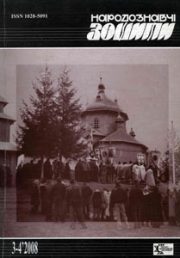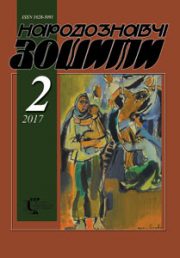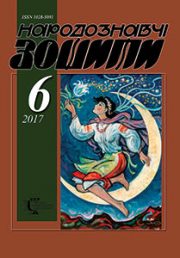The Ethnology Notebooks. 2019, 2 (146), 423—429
UDK 394.262.5 (477.86)
DOI https://doi.org/10.15407/nz2019.02.423
SEREBRYAKOVA Olena
ORCID ID: https://orcid.org/0000-0002-1039-2920
Candidate of Historical Sciences,
research worker of the Department of the modern ethnology
Ethnology Institute of the National Academy of Sciences of Ukraine
15, Svobody Avenue, 79000, Lviv, Ukraine
Contacts: e-mail: o-sereb@ukr.net
Abstract. The relevance of the article is due to the fact that there is still no special research about local peculiarities of the existence of hydromantic practices in Pokuttiа region. They are the important constituent of all varieties of girlish fortunetelling about marriage. The purpose of the study is to highlight the custom of ritual and world-view phenomena associated with the divination. Among them — varieties, prophetic signs, ritual prescriptions, prohibitions, mythological presentations, archaic elements, etc.).
The object of the research is the traditional world view, the custom and ritual culture of the inhabitants of Pokuttia, and the subject is divination with plants and water, which carried out to during various holidays of winter and summer calendar cycles. The basis for the article is materials of the author’s field research during 2013—2014, 2016—2017 in the villages of Kolomyjs’kyj, Sniatyns’kyj, Tlumats’kyj, Tysmenyts’kyj and Gorodenkivs’kyj districts of Ivano-Frankivs’k oblast’, local lore articles and works of the end of nineteenth and twentieth centuries (comparative material from other regions of Ukraine). The author’s research contains information about not only divination in Pokuttia region, but also traditional culture of other people of the world.
The author uses a comparative-historical, comparative, structural-semantic and method of cross-cultural comparisons.
Mantic traditions related to the ceremonial use of plants and water in the fortunetellings of the winter and summer cycles of holidays of the inhabitants of Pokuttia are analyzed. Their functionality, semantics, symbolism of attributes, modifications, and also degree of preservation of investigated phenomena in modern time are revealed. Most of them are hydromantic actions performed by girls and rarely guys. Аll divinations are the same in their functions (marriage, tanatological) and similar in semantics. Some of them are explained on the basis of semantic opposition or the corresponding interpretation of signs in the sense of marriage symbols (flowering branch).
It was found out that the ethnolocal version of the calendar hydromantic actions with plants in the inhabitants of Pokuttia is included in all-Ukrainian canvas, while preserving its peculiar features. In spite of partial loss of separate elements of divination and their modification, they still exist to this day. In some villages they are only remembered by old local people. It gives an opportunity in future to study the investigated phenomena on this territory.
Keywords: water, plants, Pokuttia, calendar holidays, hydromantic actions (divination), girls of marriage age, marriage.
Received 7.03.2019
REFERENCES
Marusik, P. (2000). Bellevue, my cradle: History, ethnography, life. Halych [in Ukrainian].
Voznyak, V. (2003). My village — Ukraine’s blossom. Ivano-Frankivsk: Nova Zorya [in Ukrainian].
Gachinsky, M. (2006). Essay on the history of Petrova village. Ivano-Frankivsk: Nova Zorya [in Ukrainian].
Archive of the IN NANU (Archive of the Institute of Ethnology of the National Academy of Sciences of Ukraine). F. 1. Op. 2. Od. save 704. Arc. 1—489 [in Ukrainian].
Archive of the IN NANU. F. 1. Op. 2. Od. save 550. Arc. 1—205 [in Ukrainian].
Archive of the IN NANU. F. 1. Op. 2. Od. save 565. Arc. 1—135 [in Ukrainian].
Archive of the IN NANU. F. 1. Op. 2. Od. save 608. Arc. 1—354 [in Ukrainian].
Archive of the IN NANU. F. 1. Op. 2. Od. save 533. Arc. 1—163 [in Ukrainian].
Archive of the IN NANU. F. 1. Op. 2. Od. save 590. Arc. 1—48 [in Ukrainian].
Archive of the IN NANU. F. 1. Op. 2. Od. save 521. Arc. 1—46 [in Ukrainian].
Vasilechko, L. (1994). Shutkov’s Sunday. People’s customs, ceremonies and beliefs. Broshniv: Talya [in Ukrainian].
Gerasimovich, V. (1893, serpen’). National customs, rituals and songs in the village of Krekhov, Balkov district. Truth (Vol. XVIII, Issue LIV, pp. 432—438). Lviv: Z drukarni NTSH [in Ukrainian].
Dikarev, M. (1905). The folk calendar of the Valu county (Borisov volost) in Voronezhchyn. In Materials for the Ukrainian-Russian ethnology (Vol. 6, pp. 113—204). Lviv [in Ukrainian].
Ivanov, P. (1907). Life and beliefs of the peasants of the Kupyansk district. Kharkiv province. Kharkov: Printing Business [in Russian].
Kurochkin, O.V. (1994). Ceremonial rituals (Calendar holidays and ceremonies). In Podillya: Historical and ethnographic research (Pp. 361—362). Kyiv: Dolya [in Ukrainian].
Markevich, N.A. (Ed.). (1991). Customs, Belief, Kitchen and Drinks of the Little Russians. Kyiv: Voluntary Society of Lovers of the Book of the USSR [in Russian].
Papizh, V. (1980). Some religious rites and customs of Pidgaechchyna. In The underground land: Historical and memoir collection. New York; London; Paris; Sydney; Toronto: Kiev, 1980 [in Ukrainian].
Archive of the IN NANU. F. 1. Op. 2. Od. save 698. Arc. 1—116 [in Ukrainian].
Kurochkin, O. (2004). Ukrainians in the European family: customs, ceremonies, holidays. Kуiv: Biblioteka ukrayintsya [in Ukrainian].
Archive of the IN NANU. F. 1. Op. 2. Od. save 587. Arc. 1—72 [in Ukrainian].
Metropolitan Hilarion. (1992). Pre-Christian beliefs of the Ukrainian people: Historical-religious monograph. Kyiv: Oberehy [in Ukrainian].
Archive of the IN NANU. F. 1. Op. 2. Od. save 362а. Arc. 41—77 [in Ukrainian].
Domanytskyy, V. (1912). People’s Kalendаr in the Rovno County, Volyn Guberniya. In Materials for Ukrainian Ethnology (Vol. XV, pp. 62—89). Lviv [in Ukrainian].
Gavrilyuk, N. (1997). On the local community and the differentiation of the ritual and ideological traditions of the Chornobyl Polissya. In Polissya of Ukraine: materials of historical and ethnographic research (Issue 1, pp. 339—345). Lviv: IN NANU [in Ukrainian].
Klimets, Yu.D. (1990). Kupala ceremony in Ukraine. Kyiv: Naukova dumka [in Ukrainian].
Sokolova, V.K. (1987). Calendar holidays and rituals. In Ethnography of the Eastern Slavs: Essays of traditional culture (Pp. 380—395). Moscow: Nauka [in Russian].
Dmitrieva, S.I. (1988). Folklore and folk art of Russians of the European North. Moscow: Nauka [in Russian].
Petrushevich, A.С. (1865). All-Russian diary of church, folk, family holidays and business classes will accept and divination. Lviv [in Russian].
Borosh, M., Korachon’, Z., & Tatrayi, Zh. (2006). Christmas holidays (from adventist to baptism). Folk art and ethnography (special issue 4, pp. 11—22) [in Ukrainian].
Tokarev, S. (Ed.). (1978). Calendar customs and ceremonies in countries of foreign Europe. Summer and autumn holidays. Moscow: Nauka [in Russian].







